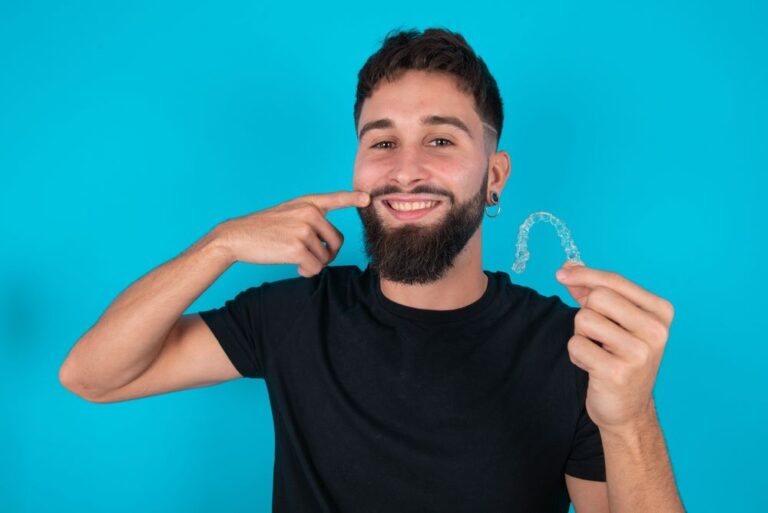Creating a good first impression is increasingly important to many tradies in New Zealand. Addressing teeth alignment issues with Invisalign not only offers a practical and discreet solution but also enhances comfort and professionalism throughout your busy schedule. This treatment allows you to confidently interact with clients and colleagues, ensuring your smile leaves a lasting positive impact.
Dental Conditions Treated
Invisalign is renowned for its ability to address a variety of dental conditions effectively, including:
- Crowded Teeth: When there is insufficient space in the jaw for all teeth to fit normally.
- Gapped Teeth: Spaces between teeth can be closed with targeted aligner movements.
- Overbite: Where the upper front teeth overlap significantly with the lower front teeth.
- Underbite: When the lower teeth protrude past the front upper teeth.
- Crossbite: When one or more upper teeth bite on the inside of the lower teeth.
- Open Bite: When there is a gap between the biting surfaces of the front and/or side teeth when the back teeth bite together.
Invisalign aligners can effectively treat these conditions through custom-designed treatment plans tailored to each patient’s needs.
Eligibility Criteria
Determining if Invisalign is the right choice involves assessing several factors. Firstly, the nature of the orthodontic issue plays a crucial role. While Invisalign can treat a wide range of conditions from mild to moderate crowding and spacing, severe cases might require alternative treatments.
It’s important to consult with an orthodontist to understand if Invisalign can effectively address your specific dental concerns.
Age is another consideration. Invisalign is suitable for almost all age groups, including children, teens, and adults. Adults can benefit from Invisalign at any age, provided they have good oral health. The condition of the teeth and gums must be optimal before starting the aligners to avoid complications during treatment.
Patient compliance is critical for the success of Invisalign. The aligners must be worn for approximately 20 to 22 hours a day and only removed for eating, drinking anything other than water, and brushing teeth. Non-compliance can lead to unsatisfactory results and prolonged treatment times.
It is also important to note that overall dental health is paramount. Conditions like gum disease or untreated cavities need to be addressed prior to starting Invisalign. Ensuring that the mouth is healthy can prevent further complications and allow for the most effective treatment outcome.
While Invisalign offers a flexible and less visible treatment option compared to traditional braces, it requires a thorough evaluation by an experienced orthodontist to ensure it is the most suitable method for your individual needs.
Financial Considerations for Invisalign Treatment
Determining the Cost
When considering Invisalign for adults, one of the primary concerns is often the cost. The price of Invisalign treatment can vary significantly depending on several factors. These include the complexity of the dental issues being addressed, the duration of the treatment, and the geographic location of the orthodontic practice.
The cost of Invisalign treatment can vary significantly based on several factors, including the complexity of tooth and jaw movements required, the number of aligners needed, and the overall length of treatment.
Generally, Invisalign costs range from NZ$3000 to NZ$11000. Factors influencing the cost include the specific treatment type chosen, the complexity of the treatment plan, and any necessary adjustments during the course of treatment.
In some cases, Invisalign can be similar to or potentially less expensive than traditional metal braces.
Getting a Quote
It’s important for potential users to get a personalized quote from a certified orthodontist. This quote will take into account the specific needs of the individual’s dental condition, as well as any additional procedures that might be required during the course of the treatment, such as attachments or refinements.
Payment Plan Options
Understanding that the cost of Invisalign can be a significant investment, many dental practices offer various payment plan options to make the treatment more accessible. These plans often allow patients to spread the cost of treatment over several months or even years. If you are unsure, just ask.
Potential Challenges with Invisalign and How to Overcome Them
Initial Discomfort
Many individuals starting with Invisalign experience initial discomfort, which is generally mild and temporary, lasting between 3 to 7 days. This discomfort is similar to that experienced with traditional braces, although many report it to be less intense.
When new aligners are introduced, it’s not uncommon for the teeth to feel sore or achy. This sensation usually diminishes within a few hours and should completely subside within 48 hours.
For those experiencing significant discomfort, especially when new to wearing aligners, there are several strategies to manage and mitigate this initial discomfort:
- Pain Relief: Over-the-counter pain relief like paracetamol can be taken to ease discomfort. It’s important to avoid anti-inflammatory painkillers as they can slow tooth movement.
- Proper Aligner Seating: Using chewies, small cylindrical cushions, can help ensure the aligners fit snugly against the teeth, which can also alleviate discomfort.
- Adjusting to Aligners: Inserting new aligners before bedtime can help one sleep through the initial discomfort. Continuous wear during the night aids in adjusting to the new set.
- Managing Sharp Edges: If discomfort is caused by the edge of an aligner or an attachment, gently filing the offending area with a nail file or contacting a dentist for adjustment can provide relief.
- Numbing Gels: For localized sore spots, over-the-counter numbing gels can offer temporary relief.
Ensuring Compliance
The effectiveness of Invisalign heavily relies on the wearer’s commitment to keep the aligners on for the recommended 20 to 22 hours per day. Non-compliance can lead to a poor fit of the aligners and consequently, an extended treatment duration or unsatisfactory results. To ensure compliance and maximize the treatment’s success, here are some useful tips:
- Routine Development: Incorporating aligner usage into daily routines can help ensure they are worn for the adequate amount of time.
- Reminders: Setting reminders on phones or watches can help maintain the discipline of wearing and removing aligners only when necessary.
- Regular Check-ins: Regular appointments with an orthodontist not only track progress but also motivate individuals to stay compliant.
- Addressing Issues Promptly: Any issues with fit or discomfort should be addressed immediately with an orthodontist to avoid prolonged problems.
By understanding these potential challenges and implementing the strategies to overcome them, individuals can enhance their experience with Invisalign and achieve the best possible outcomes.
Tips for a Successful Invisalign Experience
Daily Care
For individuals undergoing Invisalign treatment, maintaining a rigorous daily care routine is paramount. They should ensure that the aligners are cleaned regularly, ideally every time they are removed for meals or snacks.
This can be achieved by gently brushing the aligners with a soft-bristled toothbrush and rinsing them in lukewarm water. It’s crucial to avoid hot water as it can warp the aligners.
Additionally, users should brush and floss their teeth before reinserting the aligners to prevent trapping food particles and bacteria, which can lead to dental issues such as cavities and bad breath.
Dealing with Discomfort
Discomfort is a common aspect of the initial phase of wearing new aligners. To manage this, individuals can employ several practical strategies.
Chewing exercises with aligner chewies can help in adjusting the aligners better and alleviate discomfort by promoting better fit against the teeth. These exercises should be done several times a day, especially after reinstalling the aligners post meals.
If the discomfort persists, over-the-counter pain relievers can be used as per the dosage instructions. However, it is advised to consult with an orthodontist if the pain continues unabated or worsens, as this could indicate an issue with the fit of the aligners.
Conclusion
The significance of Invisalign treatment option cannot be overstated, offering a discreet, less invasive, and highly effective method for achieving a healthier smile. For adults contemplating Invisalign, this article serves as a reminder of the importance of consulting with a specialist orthodontist to fully understand how Invisalign fits within the spectrum of their unique dental needs and lifestyle.
Ultimately, embarking on the Invisalign journey, equipped with the right knowledge and expectations, can transform not just a smile, but one’s confidence and quality of life.
Get your business noticed by creating an online directory listing. Listings are FREE and you can create as many as you need.
- Get found by locals



